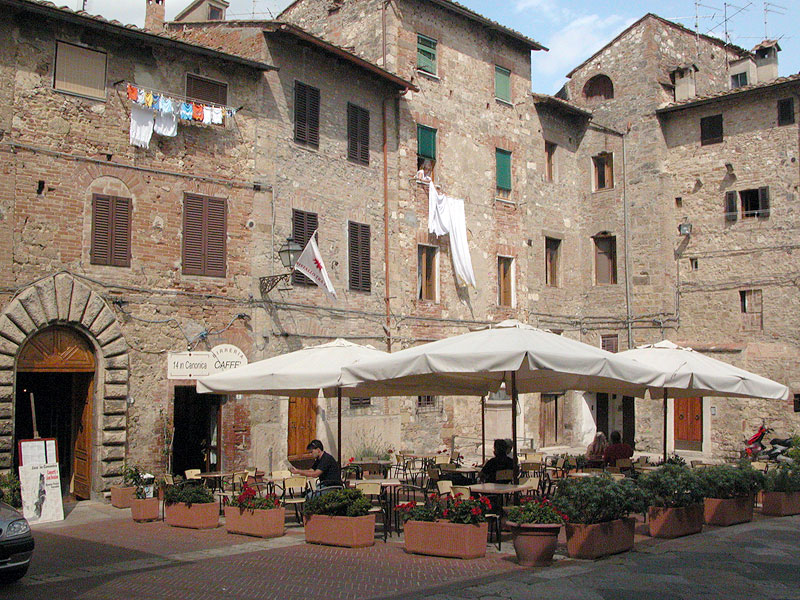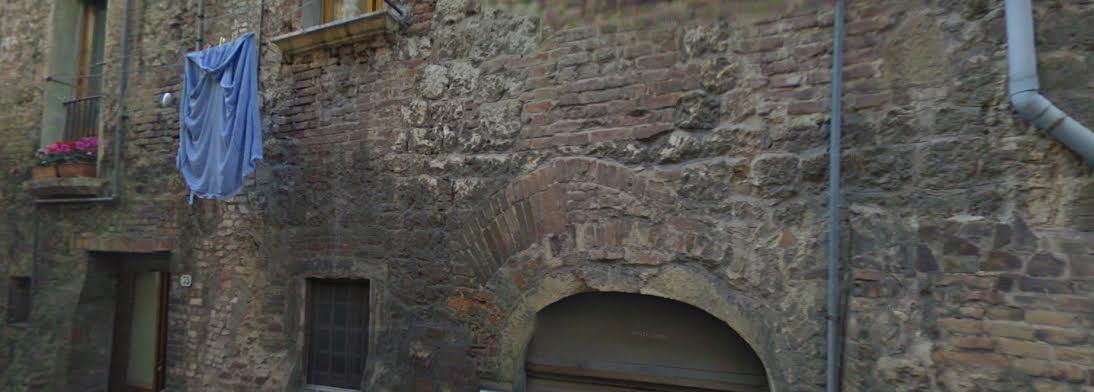
Seeing for the First Time
Things finally came to a head one sunny afternoon in Colle di Val d’Elsa, a small Tuscan hill town well off the tourist path. I was one of eighteen students of architecture in the last week of a summer abroad program in Italy. As usual, our professor, Harris Stone, brought us to a town, gave us a brief tour, and set us loose to explore. I never understood why, but they never gave us assignments. So we would walk the streets, take a few pictures, briefly try sketching a church façade or maybe a fountain, and inevitably end up writing postcards or shopping for souvenirs. While we explored, Harris would relax in a piazza, drinking espresso or wine.
We explored Colle’s historic city center but found it small and dull compared to the more spectacular hill towns we’d already seen–Siena, San Gimignano, Volterra, Pienza. Within an hour everyone had gathered back at the piazza. We were bored and hot. One of the older students, Steven, suggested we take a car and head back to Spannocchia, the agricultural estate where the program was based. We all agreed, and he told Harris.

None of us expected Harris’s reaction but we all heard it. “How can you be ready to go?” he said, his voice rising. “You haven’t seen anything yet! None of you have!” He stood up, his hand on the table to keep his balance. His lips were wet, and when he spoke again flecks of spittle flew from his mouth. I had never seen Harris like this; he was usually soft-spoken and a little fidgety. It was unnerving and slightly embarrassing.
“You haven’t sketched! You haven’t analyzed! You’ve just charged around, climbing all the towers you can find! Rewarding yourself with gelato! Go ahead! Leave! Since you don’t seem to care anyway!”
In our defense, we had already visited most of the famous hill towns. We felt like there was nothing new in this small and relatively uninteresting town. We had climbed the towers of San Gimignano, seen the worn Etruscan faces guarding the medieval gates of Volterra, and shouldered through the throngs to watch il palio, the famous horse race in Siena. Colle di Val d’Elsa just wasn’t the same caliber.
Much to his credit, Steve held his ground. “Well then teach us something, or show us something, because we don’t know what to do.”
Harris glared at Steve. We braced for more yelling, but Harris sighed and said, “Fine.” Just like that he was calm, back to the reserved professor we all knew.

Touching his mouth lightly with one hand, Harris looked around at the buildings bounding the little piazza. Then he picked up his plastic chair, marched across the stone paving, and sat down on the chair under a tree. Harris waved us over, telling us to get our sketchbooks out. I had no idea what was going on, but I was glad the tantrum was over.
Harris quietly studied the nondescript brick buildings lining the piazza in front of him. We all followed his gaze, trying to spy what had caught his attention. Like my classmates I’m sure, I searched for anything that might betray the lesson. I didn’t find anything – no quoins, no rustication, no fragments of colored plaster, no carved lintels, not a single hint. Just a row of old three-story brick residences built one against the next.
We waited. I fidgeted with my paper, smoothing it on my thigh, which would have to serve as my drawing surface. I was curious what Harris was doing, but doubted it would amount to much. I was convinced he was just pissed, and didn’t really have a lesson in mind.
“I want you to draw that façade,” Harris began, pointing at one of the buildings. “Just a line drawing, no perspective. It doesn’t have to be pretty. Make sure you get the basic proportions right, outline the walls, the ground plane, and the roof. A diagram.”
It took less than a minute.
“Now sketch in all the openings. Draw them as rectangles, don’t worry about the shutters.”

That took three minutes at most. Harris was not one to care about beautiful sketches; he cared more for their content.
“How many openings did you draw?” he asked.
We counted and agreed there were nine: a door and two windows at street level and three windows each on the second and third floors.
“That’s right,” he said. “Now I want you to draw the rest of the openings.”
When we looked confused he said, “Look at the arches above the windows. Now look at the surrounding brickwork. There are other arches there, just like the ones above the windows, but the openings have been bricked in. Look closely and you’ll see the vertical break where new courses have filled in old openings. See?”
Now that he pointed it out, we did see them, all of us all at once, so fast you could hear it–feel it–like a big collective sigh. I wondered why I hadn’t noticed them before. Now that I looked they were so obvious! I added ten or twelve filled openings to my sketch, some of which overlapped the existing windows. As I drew I noticed some of the bricked-in openings often overlapped others, and that some of the arches cut off other arches.
When we compared notes we counted twenty-five new and filled openings. Harris said he counted more, so together we counted them all and, after a lively debate, arrived at thirty-two.
Harris knew we were hooked. “Can anyone tell me what the chronology of the openings might be, or what the building first looked like?”
No one could, so Harris prompted us, opening by opening, and together we stepped backwards from the current configuration through all the iterations of openings that came before. We were stunned that we were able to do it. Our sketches, though rudimentary, helped untangle the morphological puzzle of the façade.
Harris then asked what function the building may have served. Again we were flummoxed. It was an apartment building now, why would it have been anything but that before? And how could we figure that out from the openings?
He pointed out there had once been much larger openings on the ground floor where now there were only small windows. “What could that mean?”
We all had ideas, and talked over each other trying to make our case. Someone thought it might have been an open market, another suggested a smithy, another a stable.
“That’s right!” Harris said enthusiastically. “It could have been a loggia or an undercroft for livestock. Certainly the ground floor was originally a commercial space of some sort and was later enclosed for human habitation. In the Middle Ages it was common for people to live upstairs, away from the noise and the smell of the city, above their animals.”
He looked so proud, and that made me feel different about him somehow.
“So you see,” Harris said, “If you just stop and look you can learn a great deal about even the most ordinary of buildings. Even a modest building like this one has a history, and as an architect you have the skill to retrace its history, to uncover the layers of its evolution.”

Back at school a few months later I asked Harris why we didn’t have that lesson when we first arrived. I told him it was a revelatory moment for me and I wished it had happened sooner. He looked pleased, like a proud father. He said, “You wouldn’t have been ready for it. You needed to wander around a bunch of hill towns and absorb their atmosphere, their age and history first. Only then were you ready to learn more about the evolution of those cities.”
During the remaining years of my studies I came to know Harris well, as a professor and a friend. As with the buildings he revealed to us in that lesson, I realized when I took the time to slow down and pay attention to Harris, I learned new and surprising things about him. I discovered he was a quiet man periodically roused to sharp words, much like in the piazza. Invariably after these outbursts he would share profound kernels of knowledge. I guess that was just the way he worked. At first it upset me, but over time I grew to expect these moments, and to anticipate the wisdom that followed. Like all of us, he proved to be a complex personality and, like the building in the piazza, was full of a hidden history I enjoyed uncovering.
Harris died a few years later while I was living abroad. The news devastated me. But he left me with a gift I will never forget. To this day I can’t look at a brick building without searching for half-hidden openings, without wondering what else the building might once have been. I love the sense of mystery and discovery, the thrill of unearthing hidden layers of history. And while I’m sifting through the layers I always think fondly of Harris and his powerful lesson on seeing.